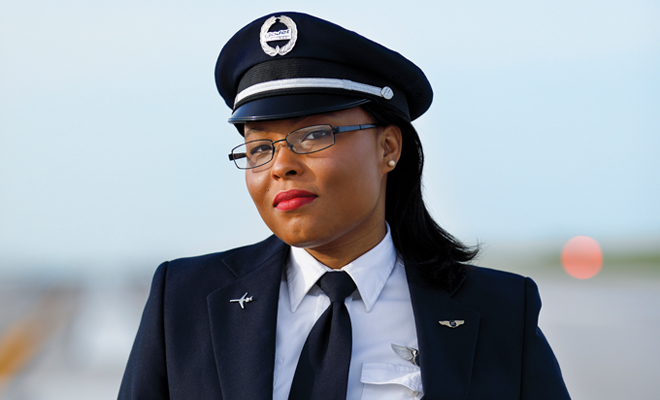 Amber Deery
Amber Deery
Dekiyra Love: Setting a Course for Aviation Success
Whether you’re dreaming about wiggling your toes in the sand on a tropical beach, fantasizing about a historical visit to the ancient Aztec or Inca civilizations of our southern neighbors or planning a family getaway to a famous theme park, you probably don’t spend much time thinking about the airline crew that will get you and your loved ones to your final destination. You’re more concerned about connecting gates and flights arriving or departing on time.
Kansas City travelers can leave the worry of travel to Dekiyra Love, a Kansas City, Kansas, resident and airline transport pilot for GoJet Airlines. The 27-year-old has been flying for several years and developed her love of aircraft and piloting the skies when she was just a young teen. But it took an aptitude test, taken early in high school, to turn her compass toward the skies.
Eyes on Aviation
“I attended Sumner Academy of Arts and Sciences in Kansas City, Kansas, which prepares students for college. In the tenth grade, you take a placement test, and it gives you suggestions on jobs based on your personality and learning styles. If you take it seriously, it will give you two career options,” advised Dekiyra. “Mine came back with two jobs: a pilot or ship captain. Both jobs deal with travel and tourism, and I’ve always wanted to travel and see the world. I researched both options, and I really liked what I was finding out about flying. So, at 16, I decided to be a pilot. It took a while to convince my family. My parents wanted me to be an aerospace engineer.”
But Dekiyra was determined to follow her dream of flying passengers and cargo. She continued her research and discovered the Lead America Youth Conference of Aviation and Aeronautics in Oklahoma City. That next summer, she attended Women Soar You Soar, an all-girls aviation camp in Oshkosh, Wisconsin, and she knew she was hooked. “My mom was a chaperone, and she saw how all these people loved the industry and how my eyes would light up when I saw the planes. It was then that my parents decided to support me,” she stated. “The camp counselors recommended Purdue University for college, and I decided that would be my number one school. In the 11th grade, I started looking at colleges, and in the spring of my senior year I found out that I was accepted at Purdue.”
Preparation for Takeoff
Her studies were intense; it required five years to obtain her bachelor’s degree in professional flight technology with a triple minor in Japanese, Asian studies and organizational leadership and supervision. She went on to get her master’s degree in aviation and aerospace management, condensing a two-year program and completing it in just a year. With her formal education wrapped, Dekiyra’s horizon was filled with nothing but blue skies.
“Typically, a career path for a pilot would be to get your certificates at a flight school, and then you get a job as a flight instructor or aerial pipeline surveyor or others to build your flight time. Then you get a job at a regional airline as a first officer,” she commented. “When you obtain your certificates, most pilots have 250 to 300 hours of flight time. You’re required by the FAA to have 1,500 hours of flight time for a job at a regional airline, but I earned credit for my college degree in aviation, which added 500 hours of flight time. Then I went to the US Aviation Academy in Denton, Texas, and taught Chinese contracted cadets. When they finish, they go back to China to fly. In 11 months of being an instructor, I got all of my necessary flight time and began applying to the regionals.”
Onward and Upward
Dekiyra joined GoJet Airlines, a regional carrier based out of St. Louis, operating commuter feeder services for United Express and Delta Connection. She liked the interview process and felt welcomed at the company. In the cockpit, with her captain, she’s behind the controls of a CRJ-700/900, a Canadair plane, which she notes is a great first regional jet to fly because of its simple design and systems. Depending on the seat configuration, she’ll carry between 65 and 75 passengers. As a first officer, she’ll pick up the flight time and experience that will allow her to move up the ladder and pin on her captain’s wings. In this role, she’ll continue to log the hundreds of hours she’ll need to move on to a mainline carrier such as Delta, Southwest, United, Hawaiian, American or Alaska Airlines, to name a few.
Not only is she logging flight time, she’s continuing an intense training schedule. Airlines and governmental regulators are keenly aware of the expectations airline passengers have to be delivered safely and efficiently to their final destinations. “I do my best to deliver people who’ve trusted me with their safety in the quickest, but most importantly, safest way I can,” she said. “If we need to delay the flight because of weather, that’s what we’ll do. If there’s a mechanical issue that won’t allow us to fly but can be fixed by maintenance, then we’ll fix it. My main concern is always safety. That’s the same for my company and the industry as a whole.”
And the airlines are in great need of highly trained and skilled pilots such as Dekiyra, especially females. A shortage of pilots looms large for the industry, and airlines understand that women can help them fill that void. “We are needed up on the flight deck because there’s such a shortage of pilots in the industry,” she stated. “Mainlines aren’t experiencing it right now, but they’re looking down the road and seeing the shortages that are out there. Right now, the flight schools are experiencing it, especially the smaller schools.”
Opportunities for Female Aviators
Female pilots make up only six percent of the total industry. With such a small showing, it can make breaking into the aviation business difficult. Yet Dekiyra has seen the lack of women in the industry for years.
“Women in the field have experienced difficulties in making it through the industry. I was the only female in most of my aviation classes at Purdue, but you get used to it. For me, it’s not an issue, but I’ve heard that it can be a struggle for other female pilots,” Dekiyra commented. “However, being a woman doesn’t make you any different from a man. You’re trained in the same standards and policies. We think about our jobs in the same way because we’ve been trained to do that. Standardization is key.”
While the lack of women in the industry is concerning, it’s mindboggling to recognize that less than 1 percent of female pilots is African-American. That equates to fewer than 100 in the entire industry. But Dekiyra and other female pilots of color are working to change this statistic. In fact, Dekiyra has been recognized by the NAACP for her community leadership and efforts to expose more African-American girls to the vocation of aviation.
Working for Diversity
“We’re really trying to get more African-American women in the industry. Sisters of the Skies is a new nonprofit organization composed of black female commercial pilots. We expose minority girls, 10 to 17 years old, to aviation and STEM [Science, Technology, Engineering and Math] through our program Girls Rock Wings. We visit aviation museums in our uniforms and give the students airplane rides while teaching them about the industry and their options,” she shared.
“Many women don’t think this is an option for them to consider as a career because it is so male dominated, but you should consider aviation. If you love to travel and visit new destinations, it’s a great option. Aviation is a really fun industry, and you don’t have to go into the airlines. You can be an aerobatic pilot, build your own planes, fly drones, transport corporate executives, carry cargo and more. This industry has so much to offer. Sure, pilots are the most visible, but there are many other industry options to enjoy such as maintenance, air traffic control, aviation management and even meteorology.”
While Dekiyra calls upon special visits to the community to share the joy of flight aviation as a career, she’s found that the best persuasion is as simple as looking out the window. “Little girls come up to the flight deck all the time and view the cockpit. I tell them to look out the window. These are my windows, and I can see the whole world and the most amazing views. You can see the sunrise and the sunset on the same day,” she remarked. “My office changes every day. Who else has an office like that? You might have the company corner office with the best views, but you would never have a view as wonderful as this.” ■









